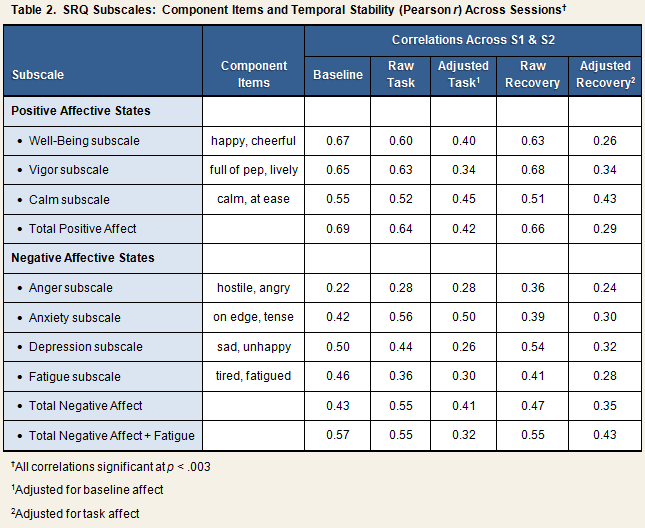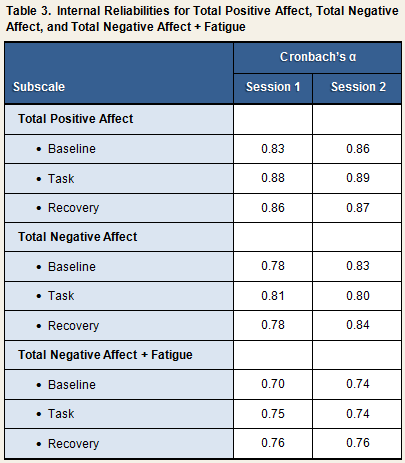Psychological Response to a Laboratory Stressor (PCS3)
Three measures of psychological state were administered throughout the laboratory stress reactivity session: the Stress Reactivity Questionnaire (SRQ), which measures state affect; the Emotional Response to Stress Questionnaire (ERSQ), which assesses the amount of effort participants put into completing the tasks; and the Rumination Measure (RM), which assesses the extent to which participants were preoccupied by the tasks after having completed them. Additional detail on each of these measures is provided below.
TitleStress Reactivity Questionnaire (SRQ) Copyright InformationNot a copyrighted scale Primary ReferenceUsala, P. D., & Hertzog, C. (1989). Measurement of affective states in adults. Evaluation of an adjective rating scale instrument. Research on Aging, 11, 403-426. PurposeTo assess the extent to which participants experience positive and negative emotions during a laboratory stressor. Type of MeasureModified. The SRQ is based on the 22-item State Adjective Questionnaire (StAQ), which assesses levels of positive and negative affect during the past 24 hours. DescriptionParticipants use a 5-point rating scale to indicate the extent to which each of 14 mood-related adjectives describe how they had been feeling during the most recently completed component of the reactivity protocol. The SRQ was administered on 3 separate occasions during the course of each of the 2 reactivity sessions. The timing of each administration and the specific instructions for reporting that were given prior to each assessment are presented in Table 1, below.
Scaling0 = Not at all, 1 = A little, 2 = Some, 3 = Quite a bit, 4 = A lot Number of Items14 Scoring/Variables and Psychometrics
|
TitleEmotional Response to Stress Questionnaire (ERSQ) PurposeTo determine the effort participants put forth in completing an induced stressful situation. In PCS3, the ERSQ was used as a manipulation check. Type of MeasureCreated for study DescriptionUsing a 7-pt scale (1 = not at all; 7 = extremely) respondents rate their level of nervousness during the laboratory task, and the extent to which they felt the task was difficult, challenging, and upsetting. Respondents also rate the level of effort they put into the task on a scale ranging from 1 (didn’t try at all) to 7 (tried as hard as I could). PsychometricsItem test-retest reliabilities (4 to 8 weeks):
Scoring/VariablesEach item is examined separately |
TitleRumination Measure (RM) PurposeTo determine the extent of rumination about an induced stressful situation. In PCS3, this measure is used to assess rumination about the laboratory stressor. Type of MeasureCreated for study DescriptionUsing a 7-pt scale (1= not at all, 7 = all the time), respondents indicate the extent to which they…
Number of Items5 PsychometricsInternal consistency, Cronbach’s α:
Test-retest reliability (4 to 8 weeks): r = 0.59 ScoringTotal rumination score = sum of all 5 items |


